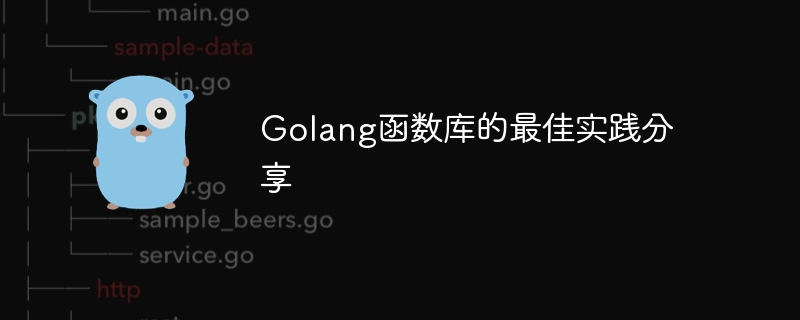
Following Go library best practices ensures that your code is efficient and reliable. Practices include: clear interfaces, rich documentation, test coverage, performance considerations, version control, and community contributions.

Go Function Library Best Practices
Function libraries are reusable blocks of code that help you write more concise, Maintainable Go code. Following best practices ensures your library is efficient and reliable.
Clear interface
Use clear interfaces to expose the functions of the function library. Explicitly specify what each function does and what inputs and outputs it expects. This prevents errors in customer code and simplifies debugging.
Example
// 合并两个切片的整数
func ConcatIntSlices(s1, s2 []int) []int {
return append(s1, s2...)
}Interface:
ConcatIntSlices(s1, s2 []int) []int
Rich documentation
Write detailed documentation for your function library. Explain the purpose, usage, and potential errors of each function. Use Go Doc comments to document function signatures, parameters, and return values.
Example
// 返回字符串中最长单词的长度
//
// s: 输入字符串
//
// 返回: 单词最长的长度, 如果 s 为空则返回 0
func LongestWordLength(s string) int {
...
}Go Doc Notes:
// LongestWordLength returns the length of the longest word in the string s. // // s: the input string // // Returns: the length of the longest word, or 0 if s is empty func LongestWordLength(s string) int
Test Coverage
for your function Write comprehensive tests for the library. This helps ensure that your code works correctly in all expected situations. Use Go's built-in testing package or third-party frameworks such as ginkgo and gomega.
Example
// 测试 ConcatIntSlices 函数的单元测试
func TestConcatIntSlices(t *testing.T) {
tests := []struct {
s1, s2 []int
expected []int
}{
{[]int{1, 2, 3}, []int{4, 5, 6}, []int{1, 2, 3, 4, 5, 6}},
{[]int{}, []int{1}, []int{1}},
{[]int{1}, []int{}, []int{1}},
}
for _, test := range tests {
result := ConcatIntSlices(test.s1, test.s2)
if !reflect.DeepEqual(result, test.expected) {
t.Errorf("ConcatIntSlices(%v, %v) got %v; expected %v", test.s1, test.s2, result, test.expected)
}
}
}Performance Considerations
Measure the performance of your library and take steps to optimize areas that may become bottlenecks . Use Go's profiling tools, such as pprof, to identify performance issues.
Example
// 无效: 使用 string(rune) 转换多个 rune 到字符串 // 有效: 使用 strings.Builder 来避免创建大量临时字符串
Version Control
Use a version control system (such as Git) to manage library code. This allows you to track changes, rollback bugs, and collaborate on development.
Community Contributions
Consider making your library open source and welcome contributions from the community. This improves the quality and reach of the library.
By following these best practices, you can write efficient, reliable, and maintainable Go libraries.
The above is the detailed content of Best practice sharing of Golang function libraries. For more information, please follow other related articles on the PHP Chinese website!




